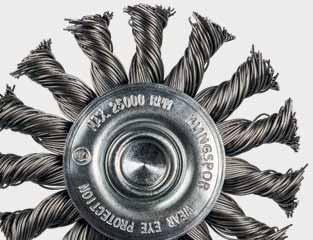
2 minute read
Wire brushes Applications guide
The most common brushes at a glance
Wheel brushes
Preparing and finishing weld seams, deburring and cleaning cutting edges, corners or angles
Cup-shaped brushes
For efficient rust, paint or weld spatter removal from large surfaces
Handheld brushes
For the manual cleaning of surfaces and weld seams
Cone brushes
For work on difficult-to-access areas, corners or edges as well as for surface cleaning
End brushes
Ideal tool for work on the insides of pipes, drill holes or indentations
Wire brushes Applications guide
1.Klingspor logotype
Reference to certified Klingspor quality
2.Safety recommendations
3.Rotational speed
Reference to maximum permissible motor speed in revolutions per minute
What the type designation reveals about the design of wire brushes
Wheel brush Wheel brush pipeline

Cup-shaped brush
Cup-shaped brush with sha
End brush with sha
Wheel brush with sha
Handheld brush with wooden handpiece
Handheld brush with plastic handpiece Fillet weld brush plug brush
Here explained by example of the BTS 600 W
4.Wire style
Klingspor offers wire brushes with knotted, crimped or SIC polyamide bristles
5.Area of application
The base colour of the tool gives an indication of the wire material used Green = stainless steel Silver = steel
Cup-shaped brush with sha polyamide bristles
Wire brushes Applications guide
Bristle materials and their properties
Wire types / style
Steel wire
High strength quality steel wire with great tensile and bending fatigue strength for exceptional economy.
Knotted
Aggressive brush action
Long service life
Minimum flexibility
Crimped
Gentle, material-friendly brush action
For sensitive surfaces and so materials
Perfect contouring to the shape of the workpiece
Non-corrosive steel wire / INOX
Quality stainless steel wire with great tensile strength for a long service life. Resistant to corrosion during applications on chromiumnickel steel, aluminium and other NF metals.
Brass wire abrasive grain. Uniform brush action thanks to the continuous release of new abrasive grain.
So , fine brass wire for the surface finish of NF metals (copper, brass).

Wire brushes Applications guide
Safe application of wire brushes
The maximum operating speed of the brush varies with the diameter of the brush and must never be exceeded for safety reasons. Before using the brush, always verify that the motor speed of the machine does not exceed the maximum operating speed of the brush.
Refer to the table below for a recommendation as to which brush diameter you can mount on which angle grinder:
Wire brushes Applications guide
Cutting speeds
The cutting speeds are dependent on the material to be processed. Working within the proper speed range is paramount to the economical operation of the brush. Depending on the material, we recommend using the following cutting speeds as guidelines:
Safe use of sha brushes
The receiving sha should be as low as possible, but should be clamped into the tool holder with a depth of no less than 15 mm. If the exposed sha length is L0 >10mm, the speed must be reduced for safety reasons.
Tool pressure
You will achieve an optimum sanding result when working only with the wire tips of the brush. Increasing the tool pressure will cause the brush to wear out faster due to wire breakage and thus reduce the service life of the brush.


